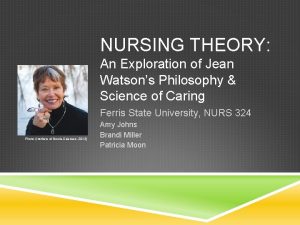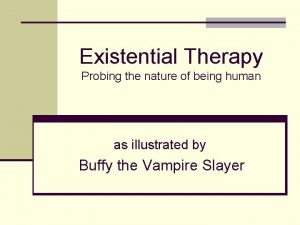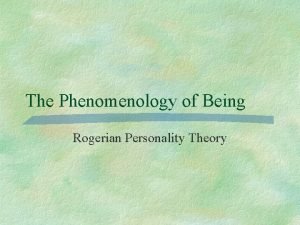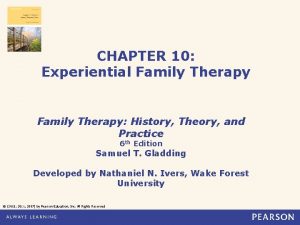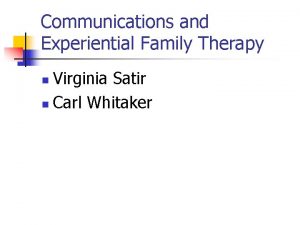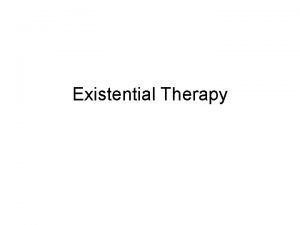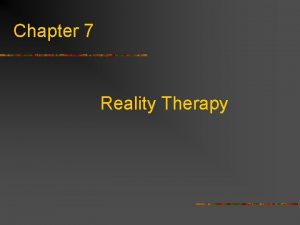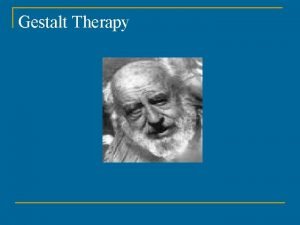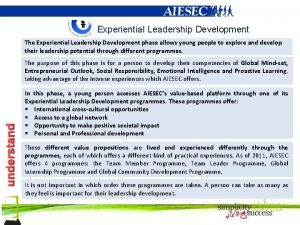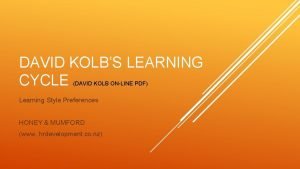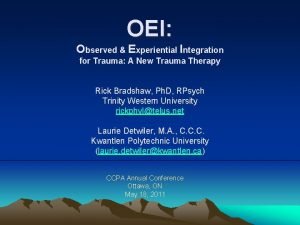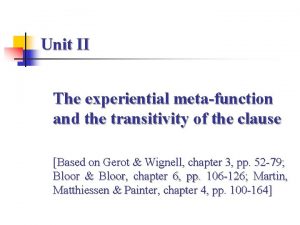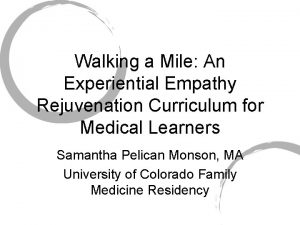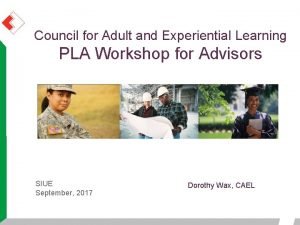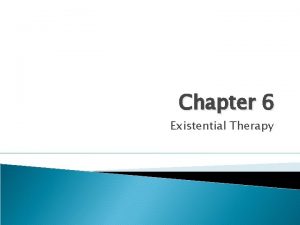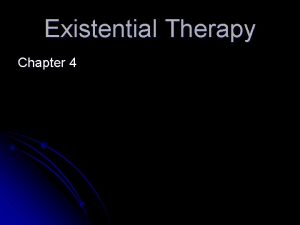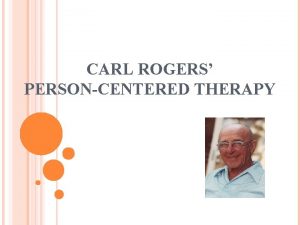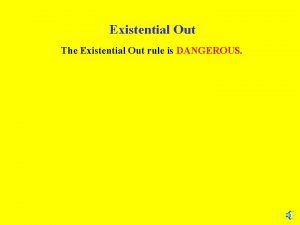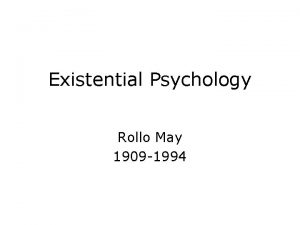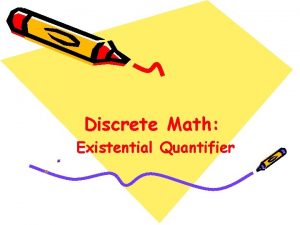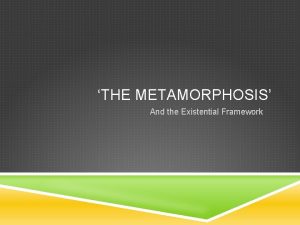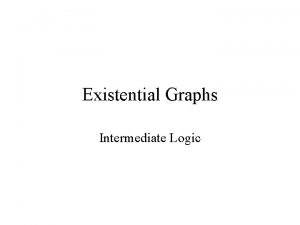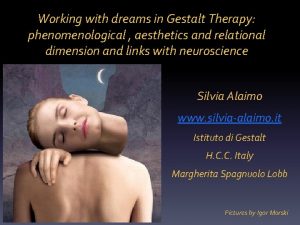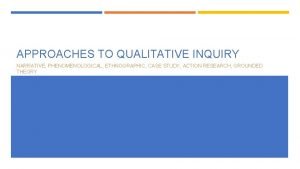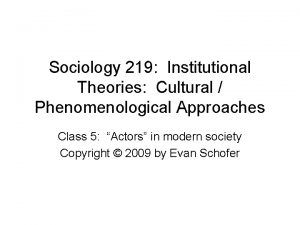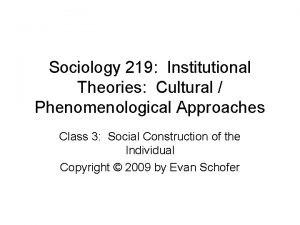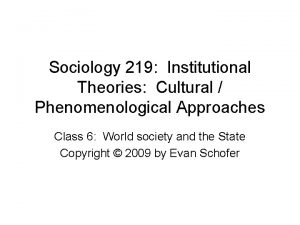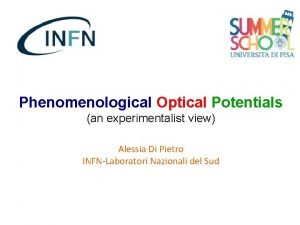Existential Experiential Therapy Existential Experiential Approaches Phenomenological view






















- Slides: 22

Existential & Experiential Therapy

Existential & Experiential Approaches ¡ ¡ ¡ Phenomenological view Dissatisfaction with prevailing scientific model in psychiatry Early proponents were psychoanalytically trained Rejection of determinism, whether psychoanalytic or behavioral While based on existential and phenomenological philosophies, emphasis upon immediate experience of being human, rather than reducing a person to fit a particular theoretical orientation

Characteristics of Existential Psychotherapy ¡ ¡ ¡ Creativity is emphasized Focus on human experiences, including inevitability of death, anxiety, and challenge of forming identity Holistic approach Emphasis on subjectivity Therapy based on human relationship “Existence precedes essence” Jean Paul Sartre: Truth is based on person’s awareness existing in a given situation at a particular time

Existential & Experiential Approaches ¡ ¡ ¡ ¡ Soren Kierkegaard (1844/1944) Frederich Nietzsche (1889/1982) Martin Heidegger (1962) Edmund Husserl (1913/1962) Martin Buber (1937/1970) Erich Fromm (1941) Paul Tillich (1952) Jean Paul Sartre (1956) Ludwig Binswanger (1958) Rollo May (1958) Victor Frankl (1963) Ernest Becker (1973) Irwin Yalom (1980) Alvin Maher (1996) Clement Vontress (Vontress & Epp, 2001)

Rollo May ¡ ¡ ¡ Rollo May was born April 21, 1909, in Ada, Ohio. His childhood was not particularly pleasant: His parents fought and eventually divorced, and his sister had a psychotic breakdown. After a brief stint at Michigan State (he was asked to leave because of his involvement with a radical student magazine), he attended Oberlin College in Ohio, where he received his bachelors degree. After graduation, he went to Greece, where he taught English at Anatolia College for three years. During this period, he also spent time as an itinerant artist and even studied briefly with Alfred Adler. When he returned to the US, he entered Union Theological Seminary and became friends with one of his teachers, Paul Tillich, the existentialist theologian, who would have a profound effect on his thinking. May received his BD in 1938. May suffered from tuberculosis, and had to spend three years in a sanatorium. This was probably the turning point of his life. While he faced the possibility of death, he also filled his empty hours with reading. Among the literature he read were the writings of Soren Kierkegaard, the Danish religious writer who inspired much of the existential movement, and provided the inspiration for May’s theory.

Rollo May ¡ ¡ ¡ He studied psychoanalysis at William Alanson White Institute, where he met people such as Harry Stack Sullivan and Erich Fromm. May attended Columbia University in New York, where in 1949 he received the first Ph. D in clinical psychology that institution ever awarded. His doctoral dissertation, published in 1950 under the title of The Meaning of Anxiety, was heralded as the beginning of existential psychotherapy After receiving his Ph. D, he went on to teach at a variety of top schools. In 1958, he edited, with Ernest Angel and Henri Ellenberger, the book Existence, which introduced existential psychology to the US. He spent the last years of his life in Tiburon, California, until he died in October of 1994.

Key Concepts ¡ ¡ ¡ “Being-in-the-world”: Understanding the immediate phenomenological world in which the client makes meaning The human world is characterized by relationships in which a person exists and chooses to participate Basic methods of embracing the difficult (e. g. , anxiety), reflecting consciously on one’s existence, and using will or intentionality to define identity

Three Worlds ¡ ¡ Umvelt: “world around; ” the biological or natural world; needs, drives and instincts Mitvelt: “withworld; ” the world of fellow human beings; relationships ¡ Eigenvelt: “own world; ” the world involving relationship with one’s self; meaning from personal perceptions (“forme-ness”); immediate selfawareness

Clients in Existential Therapy Adults ¡ College students ¡ Prisoners ¡ Artists and creative persons ¡ Groups ¡

Characteristics of Existential Therapy ¡ ¡ ¡ Various symptoms and behaviors viewed as individual’s best effort to survive or sustain oneself Human beings have the capacity to transcend their situation, even in the most oppressive setting such as prison camp Freedom and responsibility are major concerns throughout therapy process

Four Ultimate Concerns (Yalom, 1980) ¡ Death l l ¡ Freedom l l l ¡ Escape from freedom (Fromm, 1941) Personal responsibility Will Isolation l l ¡ Denial of death (Becker, 1973) Origin of anxiety Panic Fusion Meaninglessness l l Meaning making organisms Hierarchy of values

May’s Views on Psychopathology ¡ ¡ ¡ There are limits to living imposed by the natural world, social conditions (especially those imposed by powerful others), and one’s own consciousness Failure to acknowledge freedom leads to dysfunctional identification with limits Freedom and destiny are reflected in intrapersonal and interpersonal dimensions, resulting optimally, in a healthy person, the capacity for interdependence

Assessment Methods ¡ ¡ ¡ Existential therapists address both the process and content of the client’s experiences There is attention to what the body says about the person’s life experiences Presence of therapist (including attunement, authenticity, and immediacy) is the major assessment tool

Therapeutic Presence in Existential Therapy ¡ ¡ ¡ May (1980) and Yalom (1980) emphasize the value of therapeutic silence or pause, the “punctuation” of therapy session Vivification of the client’s inner world through meditation, imagery, and embodiment Encouragement to participate in experiments: “Let’s see what unfolds” Recognition of the intersubjective nature and mutuality of empathy in therapy session Emphasis upon ongoing “contract” in therapeutic alliance

Dealing with Resistance (Schneider, 2003) ¡ Vivification of resistance l l l ¡ Noting of blocks and self-defeating limits Tagging of repetitive cycles Revisitation of feelings from other “stuck” experiences Confrontation l l Focus on consequences of “stuckness” Identifying splits in personality (parts that facilitate and obstruct growth)

Research on Existential and Experiential Therapies Systematic, empirically-oriented research is limited ¡ Existential approach attracts artistic and creative therapists ¡ Qualitative research methods and models seem to be ideally suited to existential psychotherapy ¡ Existential therapy has some of the most elegant of case studies ¡

Trends in Existential Therapy ¡ ¡ Existential and experiential therapies could be on the cutting edge of holistic, alternative, and integrative approaches to health care Existential approaches are very consistent with grass-roots, advocacy, and “liberation” ideologies Experienced therapists from many backgrounds come to adopt existential viewpoint Managed care and “empirically-supported” therapy movements are somewhat antithetical to the freedom of choice and subjective evaluation of existential psychotherapy

References ¡ ¡ ¡ Becker, E. (1973) Denial of death. New York: Free Press. Binswanger, (1956). Existential analysis and psychotherapy. In E. Fromm-Reichmann & J. L. Moreno (Eds. ). Progress in psychotherapy (pp. 144 -168). New York: Grune & Straton. Buber, M. (1970). I and thou. (W. Kaufmann, Trans. ). New York: Scribner’s. (Originally published 1937). Bugenthal, J. F. T. , & Bracke, P. (1992). The future of existential-humanistic psychotherapy. Psychotherapy, 29, 28 -33. Frankl, V. (1963). Man’s search for meaning: An introduction to logotherapy. New York: Pocket Books.

References ¡ ¡ ¡ Frankl, V. (1967). Psychotherapy and existentialism: Selected papers on logotherapy. New York: Simon & Schuster. Fromm, E. (1941). Escape from freedom. New York: Holt, Rinehart & Winston. Heidegger, M. (1962). Being and time (J. Macquarrie & E. Robinson, Trans. ). New York: Basic Books. Husserl, E. (1962). Ideas: General introduction to pure phenomenology (W. R. Boyce Gibson, Trans. ). New York: Collier. (Original work published 1913). Kierkegaard, S. (1944). The concept of dread (W. Lowrie, Trans. ). Princeton, NJ: Princeton University Press. (Original work published in 1844).

References ¡ ¡ Maher, A. R. (1996). The complete guide to experiential psychotherapy. New York: Wiley. May, R. (1958). The origins and significance of the existential movement in psychology. In R. May, E. Angel, & H. Ellenberger (Eds. ), Existence: A new dimension in psychiatry and psychology (pp. 3 -36). New York: Basic Books. May, R. (1981). Freedom and destiny. New York: Norton. Nietzsche, F. (1982). Twilight of the idols. In W. Kaufmann (Ed. ), The portable Nietzsche (pp. 465563). New York: Penguin. (Originally published 1889).

References ¡ ¡ ¡ Sartre, J. P. (1956). Being and nothingness (H. Barnes, Trans. ). New York: Philosophical Library. Schneider, K. J. (2003). Existentialhumanistic psychotherapies. In A. S. Gurman & S. B. Messer (Eds. ), Essential psychotherapies: Theory and practice (2 nd ed. ) (pp. 149 -181). New York: Guilford Tillich, P. (1952). The courage to be. New Haven, CT: Yale University Press.

References ¡ ¡ Vontress, C. E. & Epp, L. R. (2001). Existential cross-cultural counseling: When hearts and cultures share. In K. J. Schneider, J. F. T. Bugenthal, & J. F. Pierson (Eds. ), The handbook of humanistic psychology: Leading edges in theory, practice and research (pp. 371 -387). Thousand Oaks, CA: Sage. Yalom, I. (1980). Existential psychotherapy. New York: Basic Books.
 Nursing metaparadigm examples
Nursing metaparadigm examples Existential therapy view of human nature
Existential therapy view of human nature Carl rogers phenomenological theory of personality
Carl rogers phenomenological theory of personality Conjoint family drawing
Conjoint family drawing Virginia satir experiential family therapy
Virginia satir experiential family therapy Existentialism activities for groups
Existentialism activities for groups Multicultural view of existentialism
Multicultural view of existentialism Bioness bits cost
Bioness bits cost What are the major humanistic therapies
What are the major humanistic therapies Both psychoanalysis and humanistic therapy stress
Both psychoanalysis and humanistic therapy stress Reality v chapter 7
Reality v chapter 7 Gestalt therapy examples
Gestalt therapy examples Experiential leadership training
Experiential leadership training Experiential learning portfolio
Experiential learning portfolio Cycle de kolb pdf
Cycle de kolb pdf Observed experiential integration
Observed experiential integration Experiential function
Experiential function Experiential futures ladder
Experiential futures ladder Experiential empathy
Experiential empathy Suss head heart habit
Suss head heart habit Ruth anne rehfeldt
Ruth anne rehfeldt Experiential metafunction
Experiential metafunction Council for adult and experiential learning
Council for adult and experiential learning
